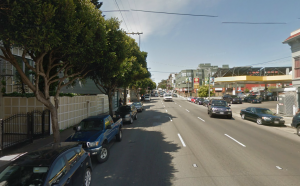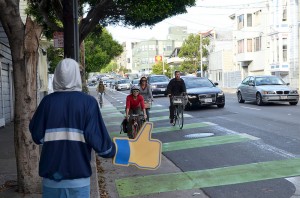
Most of us dont need convincing but it is great to see further evidence out of San Francisco on the effectiveness of cycle infrastructure for increasing the numbers of cyclists. It is estimated that the total modal share is now around 4%. For the Anglophone world this is a great accomplishment.

Some of this has been achieved by buffered lanes on a three block stretch of two major arterials, Oak and Fell Streets, (with a 58% growth in cycling) while other growth has just been the result of cycle crossing lights at the entrance to Golden Gate park(resulting in a 78% increase) and painted cycle lanes.
Another project was to narrow Baker Street, a road between Oak and Fell Streets (where the buffered cycle lanes are), by converting the parking from parallel to angled parking. An interesting concept that I will look at in more detail in a later post.

This statement in particular encapsulates the message CAA is always trying to convey to our civic and national (with a big and small ‘N’) leaders:
It’s clear that if we build it, they will come,” said Leah Shahum, executive director of the SF Bicycle Coalition, in a statement. “No other mode of transportation is growing as fast or has a higher return on investment in terms of improving our city for everyone. It’s time for the city to truly invest in our bicycle network, and ensure that our city’s streets are welcoming and comfortable for the growing number of people riding.
“Build it and they will come” – it has been true in Auckland in the last ten years for all public transport and active mode projects where official patronage estimates have been consistently conservative. There is a huge latent demand for active modes in Auckland and we need more commitment from our leaders.



